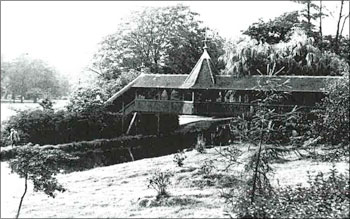The Mill Leat, Bute Park

Old Mill Leat and site of Swiss Bridge
The water-filled channel here was once part of a large mill pond at the southern end of a mill stream dug in the 12th century to carry water to the corn mills beside the West Gate. In the late 18th century, once the mills had fallen out of use, the pond was filled in. Most of the mill stream was later re-channelled to form part of the dock feeder canal (explained here). Later, the small section of channel south of Lady Bute's Bridge became an ornamental water feature stocked with water lilies and gold fish.

The mill leat area before it was drained
In the 1870s a roofed wooden footbridge – known as the Swiss Bridge – was built across the channel to give the Bute family direct access from the castle to their pleasure grounds (now Bute Park). It’s thought that architect William Burges’ design was inspired by the medieval bridge at Lucerne, Switzerland.
After the First World War, the 4th Marquess of Bute (who lived part-time at Cardiff Castle) began excavation of much of the castle’s lost heritage, including the Cardiff mills. The West Gate and the channels containing the waterwheels were restored at this time.
The bridge was moved further north, to span the dock feeder, in 1927 because the mill leat area had become cluttered since the West Gate was rebuilt in 1921. The bridge was removed after vandalism in the 1960s.

The Swiss Bridge
The water was drained from the leat in the late 1970s following a drowning and problems with flooding in the basement of the Angel Hotel on the opposite side of Castle Street.
In 2013 the overgrown channel was excavated, lined and refilled with water as part of the Bute Park Restoration Project, jointly funded by the Heritage Lottery Fund and Cardiff Council. The water is now self-contained in the channel, to prevent possible flooding downstream. The water is circulated to prevent it stagnating.

